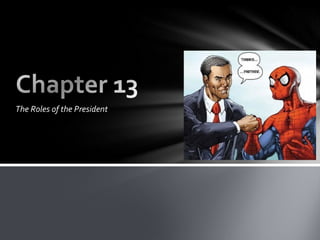
Chapter 13 section 1 and 2
- 1. The Roles of the President
- 2. Chief of State • The Ceremonial Head of Government • Formally greets head of state • Entertains in state dinners • Performs ceremonial duties
- 3. Chief Executive • vested with “the executive Power” • It is his/her role to execute and administer laws. • Appoints several thousand officials • Supervises administration of executive department • Takes care that laws are faithfully executed
- 4. Chief Administrator •Directs the huge executive branch of the Federal Government •Employs more than 2.7 million civilians and spends $3 trillion a year
- 5. Chief Diplomat • Makes foreign policy • Represents U.S. in foreign relations • Makes treaties with the approval of 2/3 of Senate • Appoints ambassadors, ministers, and consuls
- 6. Commander in Chief • Civilian military leader • Chief of the Armed forces • Determines major strategies during war • Power to declare war • Uses military power in domestic disorder to reinforce laws
- 7. Chief Legislator •Introduces most legislation •Shapes congress overall agenda while in office •Vetoes bills •Recommends measures for Congress to consider •Gives Congress information on the state of the union
- 8. Chief of Party • Automatically the acknowledged leader of their party • Leads the party and shapes their agenda
- 9. Chief Citizen •the president is expected to be “the representative of all the people” •He/she is expected to take the high road and champion public interest against private interest.
- 10. Its Good to Be King… err.. President Annual Salary = $400,000 Expense Allowance = $50,000 132 room mansion Private jet, helicopter, and limo Private getaway location
- 11. Succeed the Successful Presidential Succession Act of 1947 • VP • Speaker of House • President pro tempore (Senate) • Secretary of State • Treasury, Defense, Attorney General ~….. • 18th Secretary of Homeland Security
- 12. The jobs of “the other guy” Preside over the Senate Decide the question of Presidential Disability “Balance the Ticket” • Sarah Palin • Joe Biden
- 13. Balance This “The most insignificant office that ever the invention of man contrived or his imagination conceived.” ~ John Adams Until 1967 the VP had been vacant 18 times (that’s just under half of the administrations) 9 by succession, 2 by resignation, 7 by death
- 14. This one’s too hot, this one’s too cold Congress chooses President Direct Election of President • President would be “under • People would not be the legislative thumb” informed enough to • Originally favored by most of choose the framers • Process could become • Congress was most familiar corrupted easily with candidates • Would lead to “disorder” (how to count all the votes)
- 15. This plan is juuuust right…. Kinda What makes a good Presidential Electors Presidential Elector? • Chosen by each state • Equal to number of Senators and “Free agents” Representatives in that “The most enlightened and state respectable citizens” from each • Each elector would cast two state electoral votes (votes for a Presidential Candidate)
- 16. So what’s the plan, Stan? Whoever gets the most votes would be President. Whoever finishes second would be Vice President
- 17. Voting the Party Line Election of 1800 breaks the system Politically aligned Electors agree to vote/support party members Each party nominated 2 candidates •Ideally one would win President with the other winning Vice President
- 18. Another Hiccup Along the Way Dem-Rep vote all their votes for both Jefferson and Burr resulting in a tie The Constitution did not amend for a tie Federalist disliked both candidates Congress voted 36 times before declaring Jefferson the winner
- 19. Learning from our mistakes 12th amendment was passed in 1804 Changed the way electoral voting worked • “The electors shall name in their ballots the person voted as President, and in distinct ballots the person voted for as Vice-President” • What does this mean? • Still cast two votes • One for President and one for Vice-President
- 20. The Long Road to the White House National Conventions • Constitution does not provide for Presidential Elections • Major parties use a system that they designed to select candidates • Delegates of the party vote on who should be their parties nomination • But how are delegates chosen? (377 – 378)
- 21. How important are Primaries? Over ¾ of all Delegates come from states that hold primaries. Presidential Primary: an election in which a party’s voters choose some or all of a State party delegates to the National Convention AND express a preference for presidential nomination
- 22. Who’s on first? New Hampshire has a law Primaries began in the stating that its primary take early 1900 to battle party place “one week before any boss-dominated elections other states primaries” Each state has different Iowa holds one of the first rules for primaries Caucuses Because of their early dates a lot of front runners are determined here.
- 23. Mine all mine Winner-take-all: the candidate who won the preference vote automatically wins the support of all of the delegates chosen at that primary Proportional representation: any candidate who seeks the parties nomination AND wins at least 15% of the votes cast at the primary receive a proportion of votes equal to what they won.
- 24. What does it mean? Winner-take-all Proportional Representation: • 40% of votes = 0% • 40% votes = 40% of delegates of delegates • 60% votes = 60% of delegates • 60% of votes = • So if a state has 40 delegates and someone got 45% of vote 100% of delegates they would receive 18 delegates
- 26. Walking the Plank(s) Platform: A parties official position on key issues; what a party stands for; what a party hopes to accomplish. Plank: One issue of a parties platform. So a platform is made up of planks… get it?